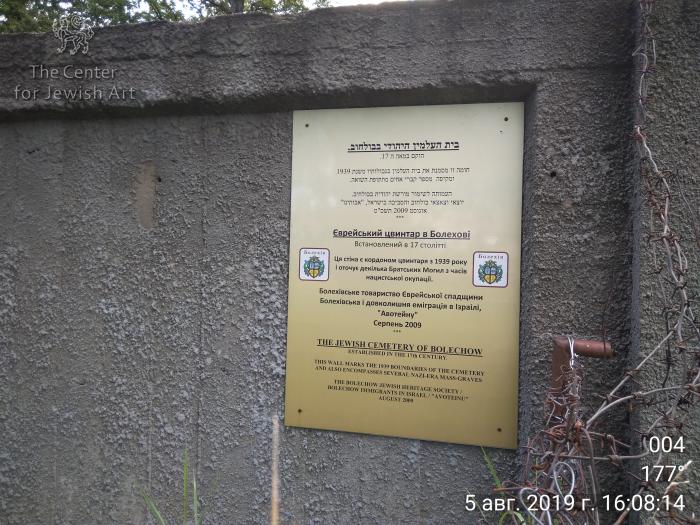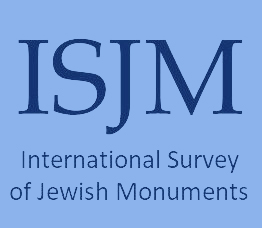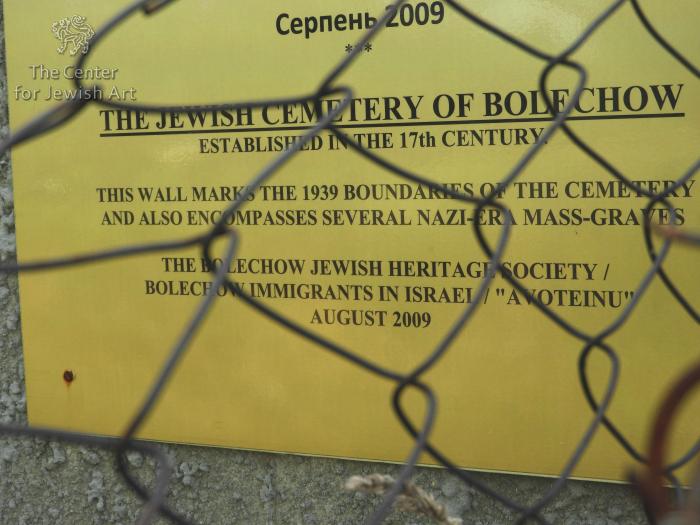Obj. ID: 49597 Holocaust Memorial plaque in the Jewish Cemetery in Bolekhiv, Ukraine

Memorial Name
No official name
Who is Commemorated?
Jewish Holocaust Victims from Bolechów who were murdered and buried in the Jewish cemetery of Bolekhiv
Description
The memorial plaque is located on the wall of the Jewish cemetery in Bolekhiv from the internal side of the wall near the entrance. The plaque bears inscriptions in Hebrew, Ukrainian, and English. Flanking the Ukrainian inscription, are the coats of arm the City of Bolekhiv used between 1991 and 2020 with the Ukrainian name of the city above them.
Inscriptions
Hebrew
בית העלמין היהודי בבולחוב.
הוקם במאה ה 17.
חומה זו את בית העלמין בגבולותיו משנת 1939
ומקיפה מספר קברי אחים מתקופת השואה.
העמותה לשימור מורשת יהודית בבולחיב.
יוצאי וצאצאי בולחוב והסביבה בישראל, ״אבותינו״
אוגוסט 2009 תשס"ט
***
Ukrainian
Єврейський цвинтар в Болехові
Встановлений в 17 столітті
Ця стіна є кордоном цвинтаря з 1939 року
і оточує декілька Братських Могил з часів
нацистської окупації.
Болехівське товариство Єврейської спадщини
Болехівська і довколишня еміграція в Ізраїлі,
"Авотейну"
Серпень 2009
***
Translation: Jewish cemetery in Bolekhiv / Established in the 17th century // This wall is a border of the cemetery since 1939 / and surrounds several mass graves since the times / of the nazi occupation. // The Bolechow Jewish Heritage Society, Emigration from Bolekhiv and surroundings in Israel, / "Avoteinu" / August 2009
English
The Jewish Cemetery of Bolechow
Established in the 17th century.
This wall marks the 1939 boundaries of the cemetery
and also encompasses several nazi-era mass-graves.
The Bolechow Jewish Heritage Society /
Bolechow immigrants in Israel / "Avoteinu"
August 2009
Commissioned by
The Bolechow Jewish Heritage Society, Bolechow immigrants in Israel, and "Avoteinu"
According to Liubov Solovka, 3,900 Jews lived in Bolechów in 1939.
According to the Encyclopedia of Camps and Ghettos, the Hungarian and Slovak armies entered Bolechów on July 6, 1941. Nazi Germany took control of it in August 1941.
The first mass murder took place on October 28–29, 1941. Between 700 and 900 Jews were gathered in a Catholic building (the House of the Red Army or DKA), tortured there, and then brought to the Taniava forest and shot. In April 1942, about 450 Jews were shot near the Jewish cemetery in Bolechów. In August 1942, Jews from Wełdzirz, Wygoda, Wyszków, Mizun Stary, and Rożniatów were brought to Bolechów. On September 3–5, 1942, about 600 Jews were murdered in the Jewish cemetery in Bolechów (400 according to the Encyclopedia) and more than 450 Jews (1,600 according to the Encyclopedia) were deported to the Bełżec killing center. About 2,000 Jews, workers in the Bolechów labor camps, were murdered in 1943 during liquidation actions. Mass murders took place on March 10–12, and June–August in the Jewish cemetery. About 3,050 Jews perished in the Jewish cemetery in Bolechów [Solovka, Liubov and Svitlana Oryshko, pp. 189–195, 526].
According to the Rohatyn Jewish Heritage, the Soviet Authority erected the monument in the Taniava Forest in the late 1940s. The plaque bore an inscription about Soviet citizens, victims of fascism, without specifying their ethnicities. By 2003, this plaque was no longer on the monument. In 2007, descendants of Bolechów Jews and other stakeholders established the Bolechów Jewish Heritage Society, which aimed to protect and commemorate the Jewish cemetery and other Jewish heritage sites in Bolechów. In 2009, the members of this organization from Israel and the United States organized and financed the cleaning of the mass graves in the Taniava Forest and in the Jewish cemetery in Bolekhiv. Descendants of a local Christian family, who saved Jews during WWII, agreed to clean up the territory systematically. In 2009, members of Bolechow Jewish Heritage Society also installed three Holocaust memorial plaques - on the mass grave in the Taniava Forest, in the Jewish cemetery near the entrance, and on the former House of Red Army ("DKA"). The House of Red Army burned down and was demolished together with the memorial plaque.
The dedication ceremony and installation of the memorial plaque in the Jewish cemetery took place on August 18, 2009. L. Kitsul, R. Matkovskyi, deputies of the city Head, and V. Lutsyk, the editor of the Newspaper of the Bolekhiv City Council "Ratusha" met about 40 descendants of Bolekhiv Jews from Israel, the United States, and France in the cemetery that day. The ceremony consisted of two parts. The first part was composed of speeches in Ukranian by Natalia Ivanochko, Vasyl Lutsyk, and priests Ivan Petriv and Kshyshtof Panasovets. The second part started with a speech by Larry Kirsch, a descendant of Bolekhiv Jews followed by the sounding od a shofar. After that, Shlomo Adler spoke and Susan Wolf Turnbull, on behalf of the organization, presented gifts to the priests of three Bolekhiv communities. Then, Psalm 23 was read, and a guest from Israel sang a song in two languages.
On August 19, 2009, dedicatory ceremonies for new memorial plaques took place near the former House of the Red Army and at the mass grave in the Taniava Forest. During the ceremony near the former House of the Red Army, a descendant of Bolekhiv Jews, Josef Adler spoke about the first "Action" in October 1941 in Yiddish. The speech was translated into English and Ukrainian. After a short prayer, all the participants moved to the Taniava Forest, where a Rabbi from Lviv took the floor with a sermon, prayer, and the sounding of a shofar.
According to the Tsal Kaplun Foundation, there is a Holocaust monument in the Jewish cemetery in Bolekhiv that was erected in the 1990s, but we could not confirm this information ["Bolekhiv: Jewish Cemetery"].
"Bolekhiv: Berezino Tract (Tanyava Forest),"
Shoah Atrocities Map - Ukraine (Tsal Kaplun Foundation), https://shoahatlas.org/u1104.html.
"Case Study 15 – Informational Signage: Bolekhiv Cemetery and Forest Mass Grave," A Guide to Jewish Cemetery Preservation in Western Ukraine (Rohatyn Jewish Heritage), https://jewishheritageguide.net/en/case-studies/cs15 (accessed May 20, 2023)
Encyclopedia of Camps and Ghettos 1933-1945, ed. Martin Dean, vol. 2 (Bloomington: The United States Holocaust Memorial Museum, 2012), pp. 751–753.
Lutsyk, Vasyl, "Bolekhivchany usogo svitu - piznaimosia," Ratusha Hazeta Bolekhivskoi Miskoi Rady, 32 (603), August 21, 2009: pp. 1, 3
Solovka, Liubov and Svitlana Oryshko, 150 iz 150 tysiach... Holokost yevreiv Prykarpattia yak skladova etnodemohrafichnoi Katastrofy Skhidnoi Halychyny, (Ivano-Frankivsk: Foliant, 2019), pp. 189–195, 525–526.







